Years ago, if you saw a tag that said “Made in the USA” you knew that product was crafted and assembled in the United States. There was no confusion related to it because it meant that Americans crafted the components using American materials, and American hands assembled the final product.
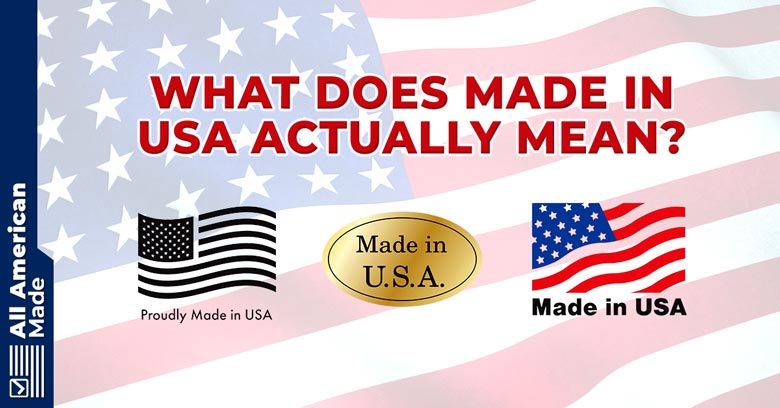
Today, things are more confusing, and even with clear guidelines in place, many companies use shady tactics to trick consumers. In the rest of this article, we’ll explain what made in the USA actually means and other important information.
According to the FTC, to label a product “Made in USA” all or virtually all of the product must be made in the United States. However, if more than a negligible amount of the product is made elsewhere, it must comply with FTC rules and carry a supplemental line such as “with global components.”
Even with the guidelines set by the FTC, many companies use confusing marketing tactics and labels such as “Made in America” which could mean made in Mexico or Canada.
The Impact of the World Trade Organization (WTO) and How We Got Here
Since the late 1970’s manufacturers started seeking cheaper materials, labor, and more ways to increase profit. Around that time, many foreign countries offered cheaper labor, lax labor laws, and a much larger, hungry labor force. Trade with foreign countries was nothing new at this time, but manufacturers were starting to notice countries like China, Mexico, and Japan could produce the same goods that were being made in America but for a much lower cost. Additionally, around these two decades, more people were able to go to colleges and universities. They were seeking higher-paying careers, and many Americans were exiting the manual labor force, which served to increase the need for foreign labor.
In 1995 the World Trade Organization (WTO) was founded. This organization made it easier for countries to trade products back and forth without being bogged down with a multitude of laws. It made sure that trade between countries was seamless, predictable, and as seamless as possible. This made it easier for American manufacturers to source cheaper materials for their products or to move their entire operations overseas for better profit.
When China entered the WTO in 2001, American manufacturing jobs and American-made products plummeted, while imports from China increased dramatically. In fact, between 2001, when China first entered the WTOm, to 2004, Chinese imports to the United States quadrupled.
With trade increasing from countries overseas, raw materials being imported from unknown origins, and smaller components being created elsewhere, the Made in USA tag no longer had a cut-and-dry meaning. Let’s look at American car companies; back before the government bailouts, Ford, GM, and Chrysler were the big three American Made car companies. You expected your car or truck to be made in America, and for all intents and purposes, it was assembled in America, but parts came from China, Mexico, Germany, and other places. Some vehicles even had motors and transmissions built-in foreign companies, then shipped to the US, where they were put into the frames.
Made in America took on a different meaning and the Federal Trade Commission set out to clear up any confusion. But… When you check out the Federal Trade Commission’s website, it’s nearly 40 pages of confusing, ambiguous language that tries to explain what “Made In USA” means. According to the FTC, their definition of Made in America states that “a product advertised as Made in USA be all or virtually all made in the U.S. From there, the site goes on to completely muddy the waters and confuse everyone about what is considered Made In USA. It doesn’t help that there are many other subsets of the “Made In USA” tags.
You can check out the FTC’s website on the country of origin tags right here; Complying with the Made in USA Standard.
Some labels you might see on your favorite products could include “Assembled in USA”, “Made in USA of Imported Parts”, and “Made in USA of U.S. and Imported Parts,” and the list continues. So this leads to the question, “What does Made in USA actually mean?” We will go over all of these terms and try to describe what each of these tags mean as well as help you be aware of some shady tactics by companies to make you think they are making goods in America when they actually are not.
Most consumer products today have a country of origin tags on them, though there is no law requiring manufacturers to mark or label their products. The exception being automobiles, textiles, and wool and fur products. Since there is a growing movement by American consumers to look for and purchase more goods manufactured domestically, a lot of companies will try to capitalize on that tactic.
Made in the USA Doesn’t Mean What it Used to
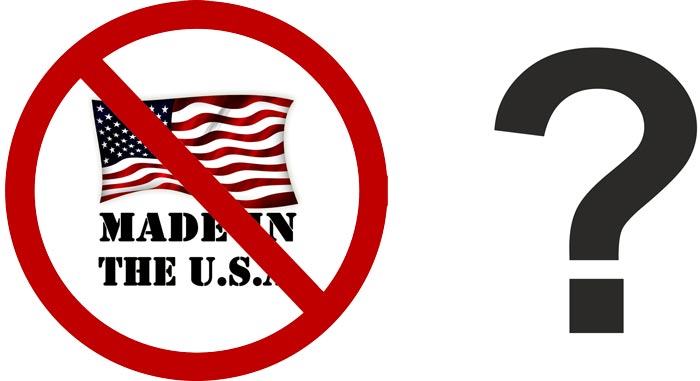
Unfortunately, when a company puts the Made in USA tag on their product, this isn’t as cut and dry as you might think. The Made in USA tag can be entered as either a qualified claim or an unqualified claim. Let’s see if we can’t clear this up a little bit.
An unqualified claim means that the manufacturer states their product is “all or virtually all” Made in the USA. This includes the 50 states, Washington DC, and all other US territories or properties, such as Puerto Rico and Guam. We can further break this down by describing what “virtually all” means. According to the FTC, the major, significant parts must be from the US, and there should be no or very little foreign content. The manufacturer also needs to be able to provide proof of this claim, all while the final assembly or finished processing has taken place in the United States.
To help explain what an unqualified Made in USA claim is, we will use a gas oven as an example. Let’s say the majority of the oven and the components are made and manufactured in Des Moines, IA. But the knobs and the tubing that supplies the gas to the burners are made in China and shipped to the factory in Iowa, where they are installed on the final product. Since these parts only add up to a “negligible” amount of foreign parts, the manufacturer can stick a Made in USA tag on the oven without any legal ramifications.
There’s no solid percentage that I have been able to find to qualify what the term “negligible” equals. Unfortunately, that part is open to some interpretation.
A qualified Made in USA claim can have that in the tag, but these products are not always entirely made in the United States. For that reason, they must add more descriptive words to the tag. These can include Made in the USA of US and imported parts, Assembled in the USA from materials imported from [Country], or Made in the USA with 50% US content. Now we will go into detail about what all these other tags truly mean, along with other examples that are hopefully easy to understand.
Made in USA of U.S. and Imported Parts
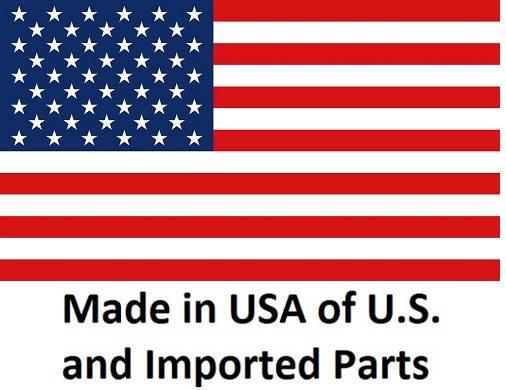
This means the product is made and manufactured in the United States with domestic parts, but there are too many imported parts to signify a negligible amount. There could be 30%, 50%, or more of the parts that are from imports. If you purchased a product that had this tag, you would still be supporting an American job, most likely the final assembly, but a fair amount of parts would be from a foreign company.
Using the gas oven again as an example, we could say this time the housing, the oven door, and the computer boards are all made in a foreign country, while the rest of the oven’s parts are made in Iowa. Then all the parts come together, and it’s assembled in the US. This time there is a significant amount of foreign parts going into the manufacture of the oven. Hence the oven was Made in the USA, but it has close to 50% US parts and 50% imported parts.
Made in USA of Imported Parts
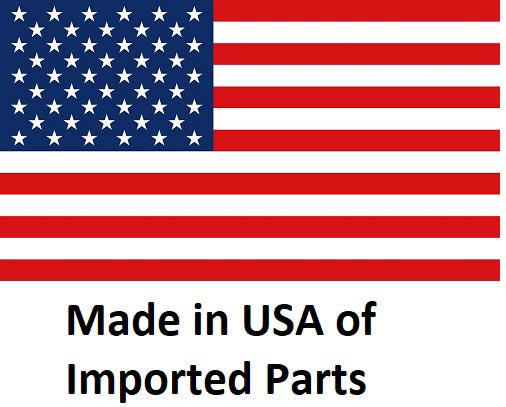
If you see this tag, it is a little more straightforward, but consumers are often falsely lulled into thinking they are purchasing a product that is completely made in the United States. This means the final construction is done in our country, but all or nearly all the parts have been imported from other countries. This still doesn’t mean the entire product was manufactured in the USA either. There could still be smaller parts such as wires, computer chips, motors, etc that were assembled in another country before coming to America, where the bigger, finished product was put together.
We’ll use the oven one more time before moving to something else. Now, let’s say all the oven components are made in Mexico. The knobs, the grates, the computer boards, the housing, hoses, everything is made in several different Mexican factories, and then they are shipped to Iowa for final assembly.
There could be a few American-made products in the oven, such as the knobs, but if the vast majority of the oven is made from foreign parts, it will have to carry such a label.
Assembled in the USA from materials imported from [Country], Assembled in USA of Imported Parts, or any similar language basically means the same thing. The finished product was made somewhere in the USA, but the biggest share of parts was manufactured and imported from another county.
Made in USA with Global Components or Global Materials
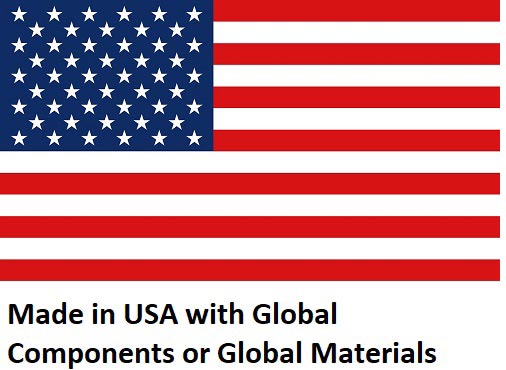
This tag is similar to the previous one in that the final product is finished in the United States. There could also be a few or no parts of the product that are made in the US, but the majority are made and imported from foreign countries. So why would manufacturers use the word “Global”? Most likely there are many different parts that come from several countries around the “globe,” but they don’t want to take the time or space to list them all. It could also mean that they import the same parts from different countries. For example, a bicycle company sends all the parts to America to be assembled, but the frame could come from China one month, then from Mexico the next month. Instead of constantly changing the label, they simply put “Made in USA with Global Components.”
Let’s further go into the difference between Global Components and Global Materials. Global components stand for a bigger piece of the final product. The bicycle, for example, has many working parts to it. There are wheels, frames, handlebars, brakes, pedals, and many more parts that go into making a whole bike. These all could be considered components. The wheel, for example, consists of the metal rim, spokes, rubber tire, and possibly a tube. These would be labeled as Global Components because each component could be made in a different country.
Materials, on the other hand, are smaller pieces of the whole and can be combined to make components. Materials could include the metal for the bike rim, the padding for the seat, the plastic for reflectors, and so on. Either way, the main takeaway here is that the product was partly or mostly assembled somewhere in the United States, but the majority of the parts have been made and manufactured elsewhere.
I even have a dog shampoo by the Burt’s Bees company which states the product is “Made In USA with Global Ingredients.” The company has sourced the shampoo ingredients from foreign sources, but they mix them together to make the final shampoo product here in America.
If you’re interested, the video below does a pretty good job explaining what made in the USA actually means. It’s not quite as in-depth as our text guide, but if you’re more of a watcher than a reader, I do recommend watching it.
What Does Assembled in the USA Mean?
Assembled in the USA, thankfully, is straightforward. This means that the majority or all of the product is put together in the United States or its territories. When you see this tag, you know basically that it’s a foreign product, with foreign-made materials that were only Assembled in the United States.
Shady Marketing Tactics
There are a lot of companies out there that are trying to get one over American consumers by using shady marketing tactics. They are starting to realize that many Americans are looking to purchase more American-made goods in a way to support our own economy and to keep more American jobs. According to Consumer Reports, 78% of Americans would rather buy American-made products compared to foreign-made equivalents.
Be Wary of American Symbols and Their Placement
Some of these shady marketing tactics can include using images synonymous with American ideals, such as the American flag, the bald eagle, or a picture of the Statue of Liberty in their labeling. One such example is a tag that reads “Made In” followed by a fine print under the flag picture of the country of origin. It appears that the product is made in America because of the picture of the flag, when in fact, it was made in India. While the company isn’t truly doing anything illegal, it can be easily misread.
Just because a company slaps a few American flag stickers on their products or labels doesn’t mean the product is made in America. But if that leads people to assume they are, then these companies will continue to do so.
Related Article: American Flags Made in the USA
Using The United States In Company Names
Some companies try to confuse consumers by using USA, America, or something similar in the name of their products or in the company name even though their products are made anywhere but in America. Some examples include:
- USA select Grills
- American Mills
- Americana Olives
- Great American Seafood
- United States Sweaters
- US Lock Company
When you look these companies up online, they may even appear to all American companies. They will work on your sensibilities, stating they are a family-owned company or something similar, they may even have their headquarters located in the United States, but they import their products. If they were truly a company that made products in the United States, they would display that fact proudly and prominently. If you can’t find where their products are manufactured or produced, you can bet they are most likely made overseas. To find out for certain, you can contact the company and ask them where their products are manufactured.
Confusing Labels
There are some products out there that continue to prey on confusion. Take a label that states “Designed in California, Assembled in India.” At first, it could seem that part of the product was made in America before being sent to India to finish the manufacturing. But in truth, the only thing that happened in America was the drawing of schematics. A sketch, or the blueprints if you will, of a product, basically was put together in California, but no product was made, no components were made, no manufacturing happened in the United States. We know the product was put together in India, but we don’t know where the parts were made. We can only assume they were not made in America.
Even food labels can be confusing. In the USA, they have an Agricultural Marketing Service that is responsible for making sure country of origin labeling is correct on certain foods. Retailers have to use signs or labels to identify where foods (commodities) come from. When you see a tag that states “Wild-Caught in Alaska” followed by “Product of Thailand,” it can be confusing. Would you believe both of them are correct? We’ll assume it was salmon that was wild-caught in Alaska, but then it took a “short” trip all the way down to Thailand for processing. The labor there is much cheaper, which makes the trip lucrative for processors, but under USDA law, that trip has to be notated. The same signage has to be displayed somewhere for fruits and vegetables as well. That’s why sometimes you will see juice companies such as Florida’s Natural stating their fruits were sourced from Brazil or Argentina. To make enough orange juice for everyone to have a cold glass after their morning coffee, the juice company has to turn to other farms to keep up with demand.
How to Spot a Fake
Aside from spending a lot of time searching online, contacting companies, and reading labels with a high-powered magnifying glass while keeping a lawyer nearby for translation, how can you make sure you’re actually buying American products and not some fake? Because of the vague FTC language and all the confusing labels, it’s basically “Buyer Beware.”Here are some ways to protect yourself from buying goods that appear to be made in the USA but aren’t.
The country of origin is supposed to be posted on a product that is imported to the United States. If you don’t see the country of origin, then it’s very likely from another country. Companies are eager to tell you their product is from the USA, and it’s against the law to state a product is Made in the USA if it is not.
If you see a lot of American flag stamps, stickers, or other insignia, be wary. A lot of companies rely on distracted consumers and assumptions. American-made products have to state explicitly “Made in the USA.” Made in (picture of) “American Flag” or Made in (picture of) “Bald Eagle” is not the same.
Look out for spelling and grammatical mistakes on labels. Non-native English speakers can easily misspell words or make small mistakes with subtle grammar nuances.
When checking websites online for products you are unsure of, look in the “About Us” section. This will often tell you where their products are made. If there isn’t much information there, be wary before purchasing anything from that site. Most American companies will be glad to tell you they started in a small hometown, then grew to hundreds of employees with hard work and strong ethics. It’s a great selling point, especially as more Americans make a bigger push for American-made products.
There are a lot of posts from people saying you can find out a country of origin by scanning barcodes or using a new app to decipher the barcode. These are misleading at best. The information provided by barcodes does not necessarily provide a country of origin, but it may give you information about where the barcode itself came from. The product could have come from Vietnam for example, and was then shipped to the United States, where the retailer put their own barcode on the product. The barcode will then tell you the country of origin was the USA, but that was only where the barcode was created. Is that confusing enough? It just means that barcodes are not reliable when determining the country of origin of a product.
Related Article: Why is Everything Made in China?
Made in America Can Mean Canada or Mexico
Consumers even have to be careful with a tag that says “Made in America.” America could still mean the countries of Mexico or Canada. The tag would not be untruthful because those countries are still a part of North America.
When we say America in our articles, we mean all of the United States, including all territories, unless it’s expressly stated.
Look For Organizations Like FMAA
Organizations like the Flag Manufacturing Association of America (FMAA) lets consumers know that they can be confident their purchase is 100% American-made. The FMAA certifies that any flag with its tag on it is made every step of the way with American materials and labor. American flags are one product that, by law, have to state where they are made from. When you purchase a flag with the FMAA tag on you, you know it was not made from foreign sources.
Textiles and Wool Products
The laws for clothing and wool products have their own separate sections for country of origin labeling. Textiles and wool products require Made In USA labels if the final products are manufactured in the United States with domestically made fabrics. Meaning a tee shirt can only have a Made In USA tag if both the fabric was made in the United States and the shirt itself was manufactured here. Although that doesn’t mean the thread or the yarn used to make the fabric can only come from the USA. The raw materials can come from another country, but everything else needs to be American-made for the tee-shirt to get a Made In USA tag.
If clothing is imported from another country, it is required to be labeled according to the laws of the Customs Service. If an article of clothing is partially made in the United States, then sent to another country to finish the manufacturing, all the countries that had a hand in the manufacturing of the product have to be added to the label.
The labels have to be attached to a conspicuous spot unless the garment is a shirt with a collar or neck. Then the label has to be affixed to the center of the neck or next to another label.
As far as catalogs, internet sales, or mail order, textiles and wool products have to state whether the products are Made in the USA, imported from another country, or both.
Automobile Labeling
Any passenger motor vehicle—manufactured on or after October 1, 1994—sold in the United States is required to have a label stating where it was assembled. This label also has to include the percentage of parts that came from the United States and Canada, as well as what country both the engine and transmission came from.
A passenger motor vehicle is defined as a vehicle that can carry no more than 12 people, has a gross weight equal to or less than 8,500 lbs, and includes both passenger vehicles and light-duty trucks. The car has to have the label displayed in a prominent location that can be clearly visible when the doors are closed, and the windows are up. It is not to be taken down until the car has been purchased.
Labels for Furs
Though fur coats and animal rugs have been declining in popularity over the years, there is still a separate category for fur labeling. The fur labeling act requires all furs and items with real fur included in the manufacture to be labeled with what kind of fur it is and the country of origin.
What To Do If You Find False Advertising
As you can see, all these different tags and qualifications can have consumers throwing up their hands in frustration. It’s up to us as consumers to be on the lookout for false claims and shady business tactics when it comes to products that are labeled as Made in the USA, but what can you do if you see a blatant attempt at false advertising?
In August of 2021, the FTC was given new authority to crack down on false Made in USA claims. Before this new act, there wasn’t much the FTC could do, and most of the claims that came in were from other companies complaining that competitors were getting “unfair advantages.” Even then, when companies did not comply with the FTC rules, they were not authorized to dole out financial penalties.
This recently updated rule gives the FTC the ability to seek “substantial monetary penalties” from countries and companies that try to falsely advertise products as Made in the USA. If the company in question is unable to prove that all or virtually all of the product in question is actually made in the United States, it can be fined rather steeply. For each violation, the FTC can impose fees and damages up to $43,280. The FTC does not think each violation will get such a stiff penalty, they hope that the new possibility of such harsh consequences will deter most blatant violations.
During your shopping, if you feel you’ve come across a falsely advertised product that claims to be Made in the USA, there are a few things you can do. You can contact the Federal Trade Commission, Division of Enforcement at (202) 326-2996, or you can email them at: MUSA@ftc.gov.
You can also contact Customs Commercial Fraud Hotline at 1-800-ITS-FAKE. This hotline is more for specific information concerning import and export fraud, such as someone removing required country of origin labels before the products get to their retail centers.
You can also reach out to the National Advertising Division of the Better Business Bureau (BBB) at NAD@BBBNP.org or contact your state’s attorney general if you have a complaint about a company’s advertising tactics.
Conclusion
With so many companies trying to confuse customers, we understand why so many people wonder what made in the USA means and why there are so many variations. We understand it can be difficult and quite confusing to figure out what all these labels mean, especially since there seem to be so many different variations. We hope we were able to clear up some of the confusion around all the different kinds of labels out there and have made you a more savvy shopper.
Hi, my name is Kevin and I’m from Pittsburgh, Pennsylvania. Choosing products made in America is important to me because it supports local economies, creates jobs, helps the environment, and ensures ethical labor practices. I also find that American made products are usually of higher quality so although they’re a little more expensive, you save money in the long run. Before starting this website I was in the USMC infantry and nowadays I work on this website as a hobby.

Check out Love of Country Clothing for items that are 100% made in the USA! From start to finish, we a proud to support and outfit Americans with products made exclusively in the USA.
Hey Joe, thanks for the comment. I will definitely check out your company and consider adding them to one of our articles.